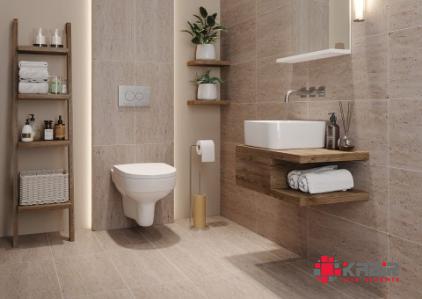When it comes to renovating your bathroom, one of the most important decisions you’ll have to make is choosing the right tiles. Bathroom tiles come in all shapes and sizes, but two popular options are large and small tiles. Each type has its own unique benefits and considerations, so it’s essential to weigh your options carefully before making a decision. In this comprehensive guide, we’ll delve into the differences between large and small bathroom tiles, their pros and cons, design ideas, and installation tips to help you make an informed choice for your next bathroom renovation project.

.
 Large Bathroom Tiles: Large bathroom tiles, typically measuring 12 inches or more in size, have gained popularity in recent years for their ability to create a sleek and modern look in bathrooms. Here are some key advantages of using large bathroom tiles: 1. Visual Impact: Large tiles can visually expand the space in your bathroom, making it appear larger and more open. This is especially beneficial for smaller bathrooms or bathrooms with limited natural light. 2. Fewer Grout Lines: Because large tiles cover more surface area, there are fewer grout lines to clean and maintain, resulting in a more streamlined and seamless look. 3. Modern Aesthetic: Large tiles are often associated with a contemporary and minimalist aesthetic, making them a popular choice for homeowners looking to achieve a modern bathroom design. 4. Easier Cleaning: With fewer grout lines, large tiles are generally easier to clean and require less maintenance compared to smaller tiles. However, there are also some considerations to keep in mind when opting for large bathroom tiles: 1. Uneven Surfaces: Large tiles may highlight uneven or sloping surfaces in the bathroom, so proper preparation and leveling of the substrate are crucial for a smooth and professional installation.
Large Bathroom Tiles: Large bathroom tiles, typically measuring 12 inches or more in size, have gained popularity in recent years for their ability to create a sleek and modern look in bathrooms. Here are some key advantages of using large bathroom tiles: 1. Visual Impact: Large tiles can visually expand the space in your bathroom, making it appear larger and more open. This is especially beneficial for smaller bathrooms or bathrooms with limited natural light. 2. Fewer Grout Lines: Because large tiles cover more surface area, there are fewer grout lines to clean and maintain, resulting in a more streamlined and seamless look. 3. Modern Aesthetic: Large tiles are often associated with a contemporary and minimalist aesthetic, making them a popular choice for homeowners looking to achieve a modern bathroom design. 4. Easier Cleaning: With fewer grout lines, large tiles are generally easier to clean and require less maintenance compared to smaller tiles. However, there are also some considerations to keep in mind when opting for large bathroom tiles: 1. Uneven Surfaces: Large tiles may highlight uneven or sloping surfaces in the bathroom, so proper preparation and leveling of the substrate are crucial for a smooth and professional installation.
..
2. Heavy and Bulky: Large tiles are heavier and more cumbersome to handle than smaller tiles, which can make installation more challenging, especially for DIY projects. 3. Limited Design Options: While large tiles offer a contemporary look, they may limit design flexibility compared to smaller tiles, which can be arranged in various patterns and layouts. Small Bathroom Tiles: Small bathroom tiles, typically measuring less than 6 inches in size, have been a classic choice for bathrooms for decades. Here are some advantages of using small bathroom tiles: 1. Versatility: Small tiles come in a wide range of colors, shapes, and patterns, allowing for endless design possibilities. From intricate mosaics to classic subway tiles, small tiles offer versatility in creating unique and personalized bathroom designs. 2. Better for Curved Surfaces: Small tiles are more flexible and better suited for curvilinear surfaces such as niches, alcoves, or rounded walls, providing a custom fit that may be challenging with large tiles. 3. Slip Resistance: Smaller tiles with more grout lines provide better traction underfoot, making them a safer option for wet areas like bathrooms.
…
4. Easy to Repair: In the event of damage, individual small tiles can be replaced without having to remove and replace an entire section of flooring or wall, making repairs more manageable and cost-effective. However, there are also considerations to take into account when using small bathroom tiles: 1. More Grout Lines: Small tiles have more grout lines, which can be harder to clean and may require more frequent maintenance to prevent mold and mildew buildup. 2. Visual Busyness: The abundance of grout lines in small tiles can create a visually busy appearance, which may not be ideal for those seeking a more minimalist or modern aesthetic. 3. Time-Consuming Installation: Installing small tiles can be more time-consuming and labor-intensive, especially when intricate patterns or mosaics are involved, requiring precision and attention to detail during the installation process. Choosing Between Large and Small Bathroom Tiles: When deciding between large and small bathroom tiles for your renovation project, consider the following factors: 1. Bathroom Size: Larger tiles are generally recommended for larger bathrooms to create a seamless look, while small tiles can add visual interest and texture to smaller bathrooms without overwhelming the space. 2. Design Style: Determine the design style you wish to achieve in your bathroom. Large tiles are ideal for contemporary and minimalist designs, while small tiles offer more versatility for traditional, vintage, or eclectic styles. 3. Maintenance: Consider your lifestyle and maintenance preferences. Large tiles require less grout cleaning but may highlight imperfections, while small tiles offer more design flexibility but require regular grout maintenance. 4. Installation: Assess the complexity of the installation process. Large tiles are easier to install on flat surfaces, while small tiles are better suited for curved or intricate layouts that may require more time and expertise.










Your comment submitted.